22 April 2016
JMW Turner announced as the face of the £20 note
20 February 2020
Current £20 note issued
5 June 2024
Issuance of banknotes featuring the portrait of King Charles III
.jpg?h=273&iar=0&w=520&hash=DB0D72B99030C1A7D75D36D40CD386DD)
Front of the Queen Elizabeth II note

Back of the Queen Elizabeth II note
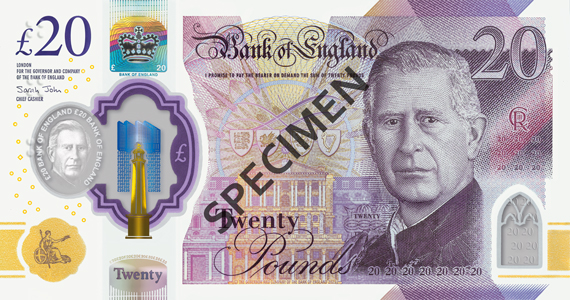
Front of King Charles III note

Back of King Charles III note
Explore our £20 note
Drag the note or use the slider to find out about the features on the note

Hologram
The word changes between ‘Twenty’ and ‘Pounds’ when the note is tilted.
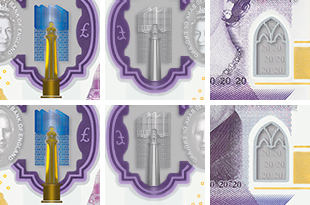
See-through windows
The foil is blue and gold on the front and silver on the back. A second, smaller window is in the bottom corner.

The monarch’s portrait
A portrait of the monarch is printed on the window with ‘£20 Bank of England’ printed twice around the edge.

Raised dots
There are three clusters of raised dots in the top left hand corner to help blind and partially sighted people identify the value of the note.
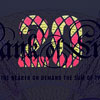
Ultra-violet number
Under ultra-violet light, the number ‘20’ appears in bright red and green, against a duller background.
Size
The higher the value of a note, the larger it is. This note is approximately 139mm x 73mm.

Purple foil patch
A round, purple foil patch contains the letter ‘T’.
Historical character
JMW Turner’s self-portrait was painted circa 1799 and is currently on display at Tate Britain.
Artwork
The Fighting Temeraire is one of Turner’s most famous paintings. This was a tribute to the ship HMS Temeraire, which played a distinguished role in Nelson’s victory at the Battle of Trafalgar in 1805.
Quote
‘Light is therefore colour’ is a quote from a lecture Turner gave in 1818 and a reference to his innovative use of light, shade, colour and tone.
Signature
Turner’s signature is from his will, in which he left many of his paintings to the nation.
Copyright symbols
The international copyright symbol is on the front and back of the note.
Unique numbering
The numbers and letters in the vertical serial number are all the same height and colour. The horizontal serial number is multi-coloured and increases in height from left to right.
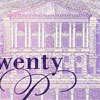
Print quality
The printed lines and colours on the note are sharp, clear and free from smudges or blurred edges.
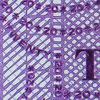
Print quality
The value of the note is written in tiny letters and numbers below the monarch’s portrait. This is visible with a magnifying glass.

Silver foil patch
A silver foil patch contains a 3D image of the coronation crown.
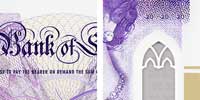
Raised print
You can feel raised print on the words ‘Bank of England’ and over the smaller window in the bottom right corner.
Key security features
Focus on these two key security features to help confirm that your notes are genuine:
Hologram image change

Tilt the note from side to side. Check the words change between 'Twenty' and 'Pounds'.
See-through window

Look at the metallic image over the window. Check the foil is gold on the front of the note and silver on the back.
Other security features
Purple foil patch

A round, purple foil patch contains the letter 'T'. You will find this on the back of the note, directly behind the silver crown on the front of the note.
The monarch's portrait in the see-through window

A portrait of the monarch is printed on the window with '£20 Bank of England’ printed twice around the edge.
Silver foil patch
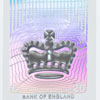
A silver foil patch contains a 3D image of the coronation crown. You will find this above the main see-through window on the front of the note.
Feel of polymer and raised print

The note is printed on polymer, which is a thin and flexible plastic material. On the front of the note, you can feel raised print. For example, on the words ‘Bank of England’ and in the bottom right corner, over the smaller window.
Print quality
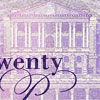
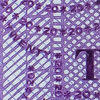
The printed lines and colours on the note are sharp, clear and free from smudges or blurred edges. If you use a magnifying glass, you will see the value of the note written in small letters and numbers below the monarch's portrait.
Ultra-violet number

Under a good quality ultra-violet light, the number '20' appears in bright red and green on the front of the note, against a duller background.
Design features
Tactile feature
On the front of the note (the side with raised print), there are three clusters of raised dots in the top left hand corner. This tactile feature helps blind and partially sighted people identify the value of the note.
Size
The higher the value of a note, the larger it is. This note is approximately 139mm x 73mm.
Unique numbering
A unique serial number is printed horizontally and vertically on the back of the note. The horizontal number is in the bottom right corner. It is made up of multi-coloured letters and numbers, which increase in height from left to right. The vertical number runs down the left-hand side and the numbers and letters are the same height and colour.
Copyright symbols
The international copyright symbol is on the front and back of the note, below the ‘Twenty Pounds’ text.
Historical characters
JMW Turner’s self-portrait was painted circa 1799 and is currently on display at Tate Britain.
Artwork
The Fighting Temeraire is one of Turner’s most famous paintings. This was a tribute to the ship HMS Temeraire, which played a distinguished role in Nelson’s victory at the Battle of Trafalgar in 1805.
Quote
'Light is therefore colour’ is a quote from a lecture Turner gave in 1818 and a reference to his innovative use of light, shade, colour and tone.
Signature
Turner’s signature is from his Will, in which he left many of his paintings to the nation.
Resources
Download our free education materials to help check your banknotes.
You can also order our free education materials online:
Watch our short film showing the key security features on the £20 note

Exchanging old notes
This note replaces our paper £20 note which was withdrawn from circulation after 30 September 2022.
You may be able to deposit withdrawn notes at your own bank or with the Post Office. Alternatively, you can exchange withdrawn banknotes with selected Post Office branches or with the Bank of England.



